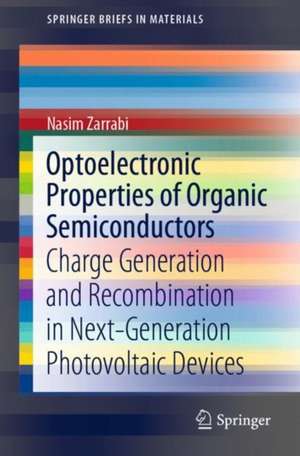Optoelectronic Properties of Organic Semiconductors: Charge Generation and Recombination in Next-Generation Photovoltaic Devices: SpringerBriefs in Materials
Autor Nasim Zarrabien Limba Engleză Paperback – 27 feb 2022
The book begins with a review of the main electro-optical phenomena in organic solar cells and presents a new method for measuring exciton diffusion lengths based on a low-quencher-content device structure. Furthermore, the book reveals how mid-gap trap states are a universal feature in organic semiconductor donor–acceptor blends, unexpectedly contributing to charge generation and recombination, and having profound impact on the thermodynamic limit of organic photovoltaic devices. Featuring cutting-edge experimental observations supported with robust and novel theoretical arguments, this book delivers important new insight as to the underlying dynamics of exciton generation and diffusion, charge transfer state dissociation, and indeed the ultimate fate of photogenerated free carriers.
Din seria SpringerBriefs in Materials
-
 Preț: 315.57 lei
Preț: 315.57 lei -
 Preț: 346.86 lei
Preț: 346.86 lei -
 Preț: 343.98 lei
Preț: 343.98 lei -
 Preț: 344.90 lei
Preț: 344.90 lei -
 Preț: 357.95 lei
Preț: 357.95 lei -
 Preț: 344.90 lei
Preț: 344.90 lei -
 Preț: 344.90 lei
Preț: 344.90 lei -
 Preț: 394.82 lei
Preț: 394.82 lei -
 Preț: 377.18 lei
Preț: 377.18 lei -
 Preț: 375.23 lei
Preț: 375.23 lei -
 Preț: 380.63 lei
Preț: 380.63 lei -
 Preț: 374.46 lei
Preț: 374.46 lei -
 Preț: 378.92 lei
Preț: 378.92 lei -
 Preț: 378.92 lei
Preț: 378.92 lei -
 Preț: 380.07 lei
Preț: 380.07 lei -
 Preț: 377.18 lei
Preț: 377.18 lei -
 Preț: 343.98 lei
Preț: 343.98 lei -
 Preț: 344.21 lei
Preț: 344.21 lei -
 Preț: 377.18 lei
Preț: 377.18 lei -
 Preț: 376.22 lei
Preț: 376.22 lei -
 Preț: 374.85 lei
Preț: 374.85 lei -
 Preț: 412.30 lei
Preț: 412.30 lei -
 Preț: 377.18 lei
Preț: 377.18 lei -
 Preț: 376.22 lei
Preț: 376.22 lei -
 Preț: 374.08 lei
Preț: 374.08 lei -
 Preț: 445.88 lei
Preț: 445.88 lei -
 Preț: 376.80 lei
Preț: 376.80 lei -
 Preț: 385.47 lei
Preț: 385.47 lei -
 Preț: 377.35 lei
Preț: 377.35 lei -
 Preț: 377.18 lei
Preț: 377.18 lei -
 Preț: 375.45 lei
Preț: 375.45 lei -
 Preț: 377.35 lei
Preț: 377.35 lei -
 Preț: 377.73 lei
Preț: 377.73 lei -
 Preț: 380.07 lei
Preț: 380.07 lei -
 Preț: 380.07 lei
Preț: 380.07 lei -
 Preț: 378.71 lei
Preț: 378.71 lei -
 Preț: 412.30 lei
Preț: 412.30 lei -
 Preț: 380.07 lei
Preț: 380.07 lei -
 Preț: 377.18 lei
Preț: 377.18 lei -
 Preț: 378.71 lei
Preț: 378.71 lei -
 Preț: 377.57 lei
Preț: 377.57 lei -
 Preț: 377.18 lei
Preț: 377.18 lei -
 Preț: 442.24 lei
Preț: 442.24 lei -
 Preț: 378.34 lei
Preț: 378.34 lei -
 Preț: 381.00 lei
Preț: 381.00 lei -
 Preț: 373.32 lei
Preț: 373.32 lei -
 Preț: 376.22 lei
Preț: 376.22 lei -
 Preț: 377.95 lei
Preț: 377.95 lei -
 Preț: 376.80 lei
Preț: 376.80 lei -
 Preț: 376.04 lei
Preț: 376.04 lei
Preț: 411.54 lei
Nou
Puncte Express: 617
Preț estimativ în valută:
78.76€ • 81.36$ • 65.55£
78.76€ • 81.36$ • 65.55£
Carte tipărită la comandă
Livrare economică 25 martie-08 aprilie
Preluare comenzi: 021 569.72.76
Specificații
ISBN-13: 9783030931612
ISBN-10: 3030931617
Pagini: 105
Ilustrații: XV, 105 p. 58 illus., 50 illus. in color.
Dimensiuni: 155 x 235 mm
Greutate: 0.19 kg
Ediția:1st ed. 2022
Editura: Springer International Publishing
Colecția Springer
Seria SpringerBriefs in Materials
Locul publicării:Cham, Switzerland
ISBN-10: 3030931617
Pagini: 105
Ilustrații: XV, 105 p. 58 illus., 50 illus. in color.
Dimensiuni: 155 x 235 mm
Greutate: 0.19 kg
Ediția:1st ed. 2022
Editura: Springer International Publishing
Colecția Springer
Seria SpringerBriefs in Materials
Locul publicării:Cham, Switzerland
Cuprins
Introduction.- Electro-Optical Phenomena in Organic Solar Cells.- Anomalous Exciton Quenching in Organic Semiconductors.- On the Effect of Mid-gap Trap States on the Thermodynamic Limit of OPV Devices.- Relating Charge Transfer State Kinetics and Strongly Reduced Bimolecular Recombination in Organic Solar Cells.
Notă biografică
Dr. Nasim Zarrabi was born and raised in Qazvin, Iran. She has pursued her passion for science in three countries. After completing her undergraduate studies in physics in Iran, she relocated first to Germany and then to Australia in 2015. She was introduced to organic electronics and began her research carrier in this field when she joined the Centre for Organic Photonics and Electronics (COPE) at the University of Queensland as a research assistant. In 2017, she moved to the UK to become part of the Sêr SAM research team in Swansea as a Ph.D. candidate. In May 2021, she completed her Ph.D. in Physics under the supervision of Dr. Ardalan Armin and Professor Paul Meredith at Swansea University. Her Ph.D. research was focused on the optical and electronic processes in disorder semiconductors, specifically, organic semiconductor devices. Dr. Zarrabi is currently a postdoctoral research associate at Swansea University, analyzing the fundamental limits of organic optoelectronic devices such as photodetectors and solar cells.
Textul de pe ultima copertă
Caracteristici
Explores the optoelectronic properties of organic semiconductors relevant for new photovoltaic devices Features a set of impressive experimental results supported by a strong and novel theoretical argument Describes a well-defined research problem and closes with a set of self-contained conclusions
